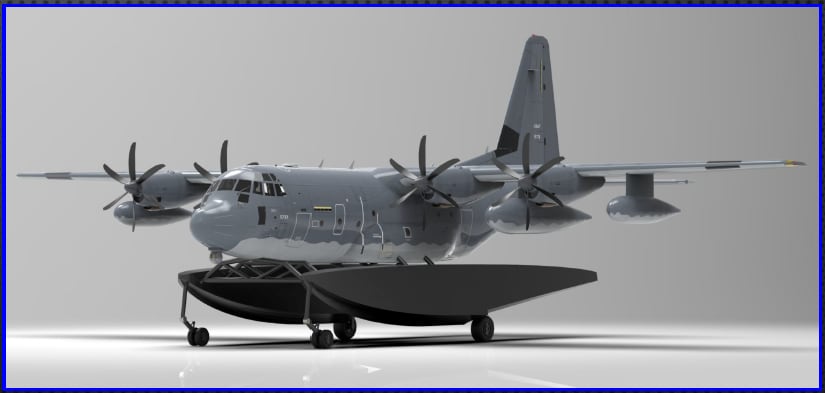Air Force Special Operations Command plans to demonstrate an amphibious version of the MC-130J Hercules by the end of next year, AFSOC’s commander told reporters Monday morning at the Air Force Association convention.
“I can say with certainty that our plan is to conduct a demo by the 31st of December next year.,” AFSOC commander Lt. Gen. Jim Slife said in a roundtable with media on Sept. 20. Slife emphasized that a flying demo would most likely feature a single aircraft and would be aimed at validating digitally engineered models that the program has run so far on the aircraft’s capabilities.
The variant of the MC-130J capable of landing on water the aircraft would be better equipped for a wider breadth of missions as the Pentagon shifts focus to littoral regions, per a Sept. 14 statement. The development has been dubbed the MC-130J Amphibious Capability, or MAC.
The latest rendered illustrations of the proposed model feature large, removable floats that would allow the aircraft to take off and land on both bodies of water and runway independent locations. In allowing significantly greater to non-traditional takeoff and landing areas, MAC would also help curtail aircraft vulnerability by avoiding easily-targetable locations.
“This capability allows the Air Force to increase placement and access for infiltration, exfiltration, and personnel recovery, as well as providing enhanced logistical capabilities for future competition and conflict,” said Lt. Col. Josh Trantham, AFSOC Science, Systems, Technology, & Innovation Deputy Division Chief in the Air Force’s statement.
The Air Force had previously announced it’s intention to develop the water-capable aircraft at the Special Operations Forces Industry Conference in May of this year, as reported by The Drive in May. Though the ept. 14 AFSOC update doesn’t provide a significant amount more detail than May’s announcement, it does note that a task force of unspecified collaborators are working with AFSOC and the Air Force Research Lab’s Strategic Development Planning and Experimentation directorate to create a prototype. The Air Force estimates an operational capability demonstration could come in as little as 17 months.
This isn’t the first time plans for an amphibious aircraft with the built-in versatility of the C-130 has come to light. Lockheed toyed with the idea of a Hercules Amphibian for the Navy as early as the 1960s, according to Tyler Rogoway’s 2015 analysis for Jalopnik, pointing out that such an aircraft would have wide-reaching applications beyond strictly battlespace operations, like rescue missions and firefighting.
While the U.S. military currently has zero seaplanes in its fleets, David Alman noted last year for War on the Rocks, that Japan, Russia, and China each operate a modest number of their own. Readiness in the Indo-Pacific could be vastly improved by the operational benefits of seaplanes’ versatility, Alman wrote, citing previous American seaplane development and operation in the early 1900s and through World War II.
Slife stressed, however, that the MAC would not be a “seaplane” per se.
“I see it referred to float plane or sea plane, which is not actually accurate,” Slife said. “It is strictly amphibious capability we’re after. In other words, utilities and land on either land or water and not be completely a maritime-only kind of platform.”
MAC prototypes are currently being tested in digital environments and through virtual reality modeling by AFSOC and companies in the private sector, according to the Air Force. AFSOC believes that these emerging tools will help streamline prototype development in such a way that accurately incorporates real-world feasibility while reducing risk.
“Being able to experiment with existing technology to evaluate design tradeoffs and test a new system before ever bending metal is a game-changer,” said Maj Kristen Cepak, AFSOC Technology Transition Branch Chief.
Air Force Times reporter Rachel Cohen contributed to this story.





